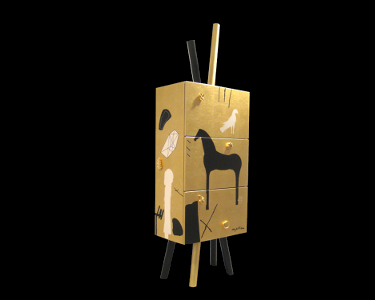Shopping cart
No products
Prices are tax included
![]()



Aristocratic collector of beautiful things.
When one speaks of Cleto Munari, what often comes to mind is the image of an aristocratic collector of beautiful things without the objective of affirming projects, trends, or ideologies, but simply for the pleasure of seeing them, or better yet, of seeing them be born. Because Munari has, at the same time, the intuition and the ample eclecticism of the big collectors, but his “beautiful things” are not sought after in the shop windows or in some dusty warehouse but rather in the mind of his designer friends, explaining to them his ideas and intuitions and waiting patiently as they take form, first on drawing paper and then through a process similar to the distilling of liquor and consisting of comparing and correcting prototypes on the base of not only visual experience but tactile, weighty, and even acoustic in certain cases. Munari is therefore an “author” even if the author is missing a watch and, the manic cult of his own “personal style”, is a “colloquial author” that utilizes the creativity of others without sacrificing his own, and reserves for himself, of the creation, two essential moments, even if normally rarely considered, the initial program and the self-critical journey that leads to the realization of the prototype.

CLETO MUNARI (1930, GORIZIA)
He founded Cleto Munari Design Associates in 1972 with it’s primary objective the research of image, form and style. In 1985 he opened a studio in Vicenza where, with world famous architects, he created jewellery worldwide. His creations are in many museum collections around the world, including the Metropolitan Museum of Art and MoMA, New York.

ALESSANDRO MENDINI (1931, MILAN)
Designer and architect, co-founder of the Domus Academy, he was awarded the Compasso d’oro for design twice in 1979 and 1981. Since 1989 he has designed two underground stations in Naples, the Groningen Museum and the Mendini Gallery. As the creator of the famous “Proust” chair, he continuously pushes the boundaries of what products could be.

MIMMO PALADINO (1948, PADULI)
First a conceptual photographer, he shifted his attention to figurative painting in the late 70s, and became a central figure of the Transavangarde moment. He was part of the Aperto ’80 exhibition curated by Achille Bonito Oliva for the 1980 Venice Biennale. His numerous solo exhibitions have been held in public museums and private galleries worldwide.

SANDRO CHIA (1946, FLORENCE)
Initially focusing on conceptual art during the 1970s under Yves Klein’s influence, painting gained increasing importance for the artist, reflecting tradition and history in a subjective-expressive way. He was part of Documenta 7 and of the 1988 Venice Biennale. A well known and respected artist, his works are in collections worldwide.
